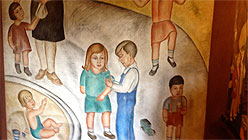Two-hundred thousand visitors show up at Coit Tower in San Francisco every year, and most of them seem to ignore one the most fascinating and enjoyable art treasures in the country: the depression-era murals that cover the tower’s walls. In the course of preparing a video story on the state of the murals for the PBS NewsHour, I watched as hundreds of tourists entered the tower, paid $7 for an elevator ride to the top, and hardly gave a second glance to the frescos painted by 25 artists during the depression.
Those art works may be in jeopardy from weather and official (as well as tourist) neglect. In fact, many of the 2500 murals from that era in schools and post offices and other public buildings, have already been destroyed, and more could be, as the post offices are closed around the country, some of them home to valuable art.

Coit Tower was built in 1933 atop Telegraph Hill with money — $125,000 — bequested to the city for its beautification by a wealthy, eccentric widow, Lillie Hitchcock Coit. It stands out on the San Francisco skyline, viewable from miles around.
When Franklin Roosevelt decided to put out-of-work artists back to work, the recently-dedicated tower was chosen as one of the sites in the country for murals. In less than a year, artists had turned the walls of the tower into a grand display of realistic art depicting life in California in the ’30s. It’s lovely stuff; there are city scenes of congestion and crime, views of tranquil country life, agriculture and leisure. Some panels portray a distinct political message: certainly leftist and pro worker. Others are completely non political and show Californians at play, in collegiate sports and outdoor recreation. The quality of the art is high, and the scenes of California evoke awe and nostalgia.





